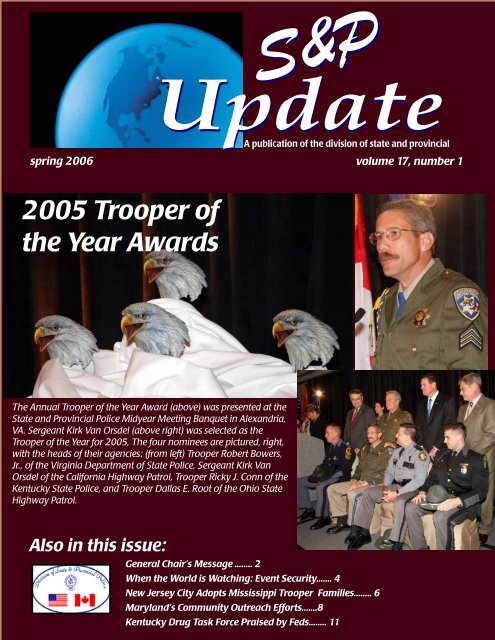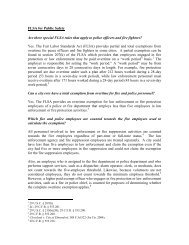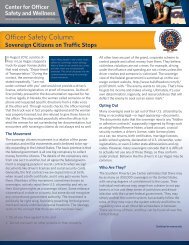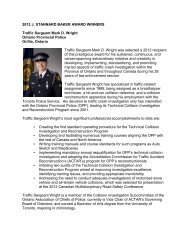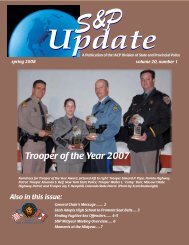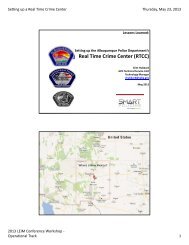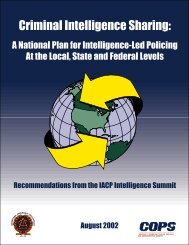2005 Trooper of the Year Awards - OJP Information Technology ...
2005 Trooper of the Year Awards - OJP Information Technology ...
2005 Trooper of the Year Awards - OJP Information Technology ...
Create successful ePaper yourself
Turn your PDF publications into a flip-book with our unique Google optimized e-Paper software.
S&P<br />
Update<br />
spring 2006<br />
A publication <strong>of</strong> <strong>the</strong> division <strong>of</strong> state and provincial<br />
volume 17, number 1<br />
<strong>2005</strong> <strong>Trooper</strong> <strong>of</strong><br />
<strong>the</strong> <strong>Year</strong> <strong>Awards</strong><br />
The Annual <strong>Trooper</strong> <strong>of</strong> <strong>the</strong> <strong>Year</strong> Award (above) was presented at <strong>the</strong><br />
State and Provincial Police Midyear Meeting Banquet in Alexandria,<br />
VA. Sergeant Kirk Van Orsdel (above right) was selected as <strong>the</strong><br />
<strong>Trooper</strong> <strong>of</strong> <strong>the</strong> <strong>Year</strong> for <strong>2005</strong>. The four nominees are pictured, right,<br />
with <strong>the</strong> heads <strong>of</strong> <strong>the</strong>ir agencies: (from left) <strong>Trooper</strong> Robert Bowers,<br />
Jr., <strong>of</strong> <strong>the</strong> Virginia Department <strong>of</strong> State Police, Sergeant Kirk Van<br />
Orsdel <strong>of</strong> <strong>the</strong> California Highway Patrol, <strong>Trooper</strong> Ricky J. Conn <strong>of</strong> <strong>the</strong><br />
Kentucky State Police, and <strong>Trooper</strong> Dallas E. Root <strong>of</strong> <strong>the</strong> Ohio State<br />
Highway Patrol.<br />
Also in this issue:<br />
General Chair’s Message ........ 2<br />
When <strong>the</strong> World is Watching: Event Security....... 4<br />
New Jersey City Adopts Mississippi <strong>Trooper</strong> Families........ 6<br />
spring 2006<br />
Maryland’s Community Outreach Efforts.......8<br />
Kentucky Drug Task Force Praised by Feds........ 11
Message from <strong>the</strong> General Chair<br />
Our midyear meeting, according to<br />
your evaluations, was a resounding<br />
success. I thank all <strong>of</strong> you<br />
who took <strong>the</strong> time to attend and also to<br />
submit your evaluations.<br />
If you still have surveys or feedback<br />
on <strong>the</strong> midyear, please forward<br />
<strong>the</strong>m or call S&P Division Director<br />
Dave Tollett so that we can best meet<br />
<strong>the</strong> needs <strong>of</strong> our membership in <strong>the</strong><br />
future. The evaluation reports form a<br />
major component in <strong>the</strong> formation <strong>of</strong><br />
plans for next year’s meeting.<br />
As you are aware, many issues and<br />
timely topics were discussed over <strong>the</strong><br />
week and we look forward to Colonel<br />
Rick Fuentes’s Homeland Security<br />
Committee report when we meet again<br />
in Boston in October. Your Executive<br />
will be following up on a number <strong>of</strong><br />
issues raised. A conference call will be<br />
convened shortly.<br />
We express our many thanks to<br />
our sponsors who continue to make our<br />
“The <strong>Trooper</strong> <strong>of</strong> <strong>the</strong> <strong>Year</strong><br />
Award Banquet is always a<br />
wonderful way to conclude <strong>the</strong><br />
midyear meeting and this year,<br />
once again, was no exception.”<br />
midyear meeting possible.<br />
The <strong>Trooper</strong> <strong>of</strong> <strong>the</strong> <strong>Year</strong> Award<br />
Banquet is always a wonderful way to<br />
conclude <strong>the</strong> midyear meeting and this<br />
year, once again, was no exception. The<br />
keynote speaker this year was Commissioner<br />
Giuliano Zaccardelli <strong>of</strong> <strong>the</strong> Royal<br />
Canadian Mounted Police.<br />
It is truly humbling to listen to <strong>the</strong><br />
events that brought <strong>the</strong>se members and<br />
<strong>the</strong>ir families to this occasion. Each one<br />
<strong>of</strong> us is reminded <strong>of</strong> <strong>the</strong> courage and<br />
pr<strong>of</strong>essionalism that members <strong>of</strong> <strong>the</strong><br />
state and provincial agencies exhibit on<br />
a daily basis.<br />
Commissioner Gwen Boniface<br />
My congratulations to all <strong>of</strong> <strong>the</strong><br />
finalists, particularly Sergeant Kirk Van<br />
Orsdel <strong>of</strong> <strong>the</strong> California Highway Patrol—our<br />
<strong>Trooper</strong> <strong>of</strong> <strong>the</strong> <strong>Year</strong> <strong>2005</strong>.<br />
Respectfully,<br />
Commissioner Gwen Boniface<br />
Fallen S&P Officers<br />
The S&P Division wishes to<br />
acknowledge <strong>the</strong> following troopers,<br />
who made <strong>the</strong> ultimate sacrifice for<br />
<strong>the</strong>ir communities and <strong>the</strong> people <strong>the</strong>y<br />
served. We extend our prayers and<br />
deepest sympathies to <strong>the</strong>ir families,<br />
friends and colleagues.<br />
<strong>Trooper</strong> Steven R. Smith<br />
Oklahoma Highway Patrol<br />
February 9, 2006<br />
Officer Earl Scott<br />
California Highway Patrol<br />
February 17, 2006<br />
<strong>Trooper</strong> Kevin C. Manion<br />
Virginia State Police<br />
February 18, 2006<br />
Officer Gregory John Bailey<br />
California Highway Patrol<br />
February 25, 2006<br />
<strong>Trooper</strong> Andrew J. (AJ) Sperr<br />
New York State Police<br />
March 1, 2006<br />
“They will be remembered—not for <strong>the</strong><br />
way <strong>the</strong>y died, but for how <strong>the</strong>y lived.”<br />
— Vivian Eney<br />
IACP Division <strong>of</strong> State and Provincial Police<br />
General Chair<br />
Gwen Boniface, Commissioner, Ontario Provincial Police<br />
1st Vice Chair<br />
Colonel Rick Fuentes, New Jersey State Police<br />
2nd Vice Chair<br />
Colonel Steven Paré, Rhode Island State Police<br />
Secretary/Treasurer<br />
Colonel Deborah Campbell, New York State Police<br />
North Atlantic Regional Chair<br />
Commissioner Jeffrey B. Miller, Pennsylvania State Police<br />
Sou<strong>the</strong>rn Regional Chair<br />
Colonel Christopher A. Knight, Florida Highway Patrol<br />
North Central Regional Chair<br />
Colonel Paul D. McClellan, Ohio State Highway Patrol<br />
Mountain Pacific Regional Chair<br />
Commissioner Michael L. Brown, California Highway Patrol<br />
S&P Division Director<br />
David L. Tollett<br />
S&P UPDATE is <strong>the</strong> <strong>of</strong>ficial publication <strong>of</strong> <strong>the</strong> Division <strong>of</strong> State and Provincial<br />
Police <strong>of</strong> <strong>the</strong> International Association <strong>of</strong> Chiefs <strong>of</strong> Police. Sharing <strong>of</strong> material published<br />
in this newsletter is encouraged among all state and provincial police agencies.<br />
Submissions are encouraged and should be sent to <strong>the</strong> newsletter editor, Carolyn<br />
Cockr<strong>of</strong>t, IACP, 515 North Washington Street, Alexandria, VA 22314;<br />
1-800-THE-IACP; cockr<strong>of</strong>tc@<strong>the</strong>iacp.org<br />
<br />
s&p update
People in S&P<br />
Lt. Col. Michael Berthay, a 28-<br />
year law enforcement pr<strong>of</strong>essional, has<br />
been appointed chief <strong>of</strong> <strong>the</strong> Mississippi<br />
Highway Patrol by Governor Haley<br />
Barbour. Berthay has served since 2004<br />
as director <strong>of</strong> <strong>the</strong> Mississippi Bureau <strong>of</strong><br />
Investigation, a division <strong>of</strong> <strong>the</strong> Department<br />
<strong>of</strong> Public Safety. MBI is responsible<br />
for investigative support <strong>of</strong> <strong>the</strong><br />
Highway Patrol’s uniformed division,<br />
providing assistance to local, state and<br />
federal agencies as well as managing <strong>the</strong><br />
Criminal <strong>Information</strong> Center.<br />
“During his long and distinguished<br />
career at <strong>the</strong> highway patrol, he has seen<br />
all aspects <strong>of</strong> law enforcement up close<br />
and personal, and I know his contributions<br />
to public safety in Mississippi will<br />
be substantial,” said Gov. Barbour.<br />
Berthay was commissioned by <strong>the</strong><br />
MHP in 1982. He has served on <strong>the</strong><br />
Interdiction Team and as a sniper on <strong>the</strong><br />
SWAT Team. In a succession <strong>of</strong> promotions,<br />
he also received o<strong>the</strong>r assignments<br />
in investigative and management<br />
positions in law enforcement, including<br />
Mark Your Calendar<br />
May 15-17:<br />
June 5-6:<br />
June 7-10:<br />
June 5-9:<br />
June 11-14:<br />
June 14-16:<br />
July 9-14:<br />
July 23-27:<br />
spring 2006<br />
North Central Region, Columbus, OH<br />
Vehicle Theft, San Diego, CA<br />
Col. Michael Berthay, left, accepts his<br />
appointment as chief <strong>of</strong> <strong>the</strong><br />
Mississippi Highway Patrol as Gov.<br />
Haley Barbour, right, looks on.<br />
a special assignment with <strong>the</strong> federal<br />
Drug Enforcement Administration.<br />
Berthay holds a bachelor’s degree<br />
from <strong>the</strong> University <strong>of</strong> Mississippi and<br />
is a graduate <strong>of</strong> <strong>the</strong> FBI National Academy,<br />
<strong>the</strong> Bureau <strong>of</strong> Alcohol, Tobacco<br />
and Firearms New Agent Academy and<br />
<strong>the</strong> U.S. Treasury Academy for Criminal<br />
Investigation. µ<br />
Highway Safety Committee Midyear, San Diego, CA<br />
LEIM Conference, Grapevine, TX<br />
North Atlantic Region, Burlington, VT<br />
DRE Section’s 12th Training Conference, Kansas City, MO<br />
SPPADS, Orlando, FL<br />
SPPPOS, San Antonio, TX<br />
August 27-29: Mountain Pacific Region, Jackson Hole, WY<br />
October 14-18: IACP Annual Conference, Boston, MA<br />
To Communicate or<br />
Not To Communicate<br />
By Colonel Steven M. Pare, Rhode<br />
Island State Police<br />
In any organization, one <strong>of</strong> <strong>the</strong><br />
most common problems that<br />
must be continually addressed is<br />
communication. Whe<strong>the</strong>r it be management,<br />
collective bargaining units,<br />
or general employees, <strong>the</strong> fear <strong>of</strong> <strong>the</strong><br />
unknown or <strong>the</strong> failure to provide<br />
direction and purpose adequately can<br />
be crippling and costly.<br />
Several years ago <strong>the</strong> Rhode<br />
Island State Police and <strong>the</strong> Rhode<br />
Island <strong>Trooper</strong>s Association set out to<br />
open <strong>the</strong> lines <strong>of</strong> communication by<br />
holding monthly meetings between<br />
top state police administrators and<br />
<strong>the</strong> collective bargaining union’s<br />
<strong>of</strong>ficers. These meetings were<br />
established to discuss issues, listen to<br />
ideas, provide and receive feedback<br />
in a low-key and informal setting.<br />
We have experienced numerous<br />
successes with this program and have<br />
discovered and solved small issues<br />
prior to <strong>the</strong>ir becoming large problems.<br />
Fur<strong>the</strong>rmore, <strong>the</strong>se meetings<br />
have increased <strong>the</strong> trust and respect<br />
between management and <strong>the</strong> labor<br />
union to <strong>the</strong> degree that both sides<br />
<strong>of</strong>fer confidential information prior<br />
to its being made public, with <strong>the</strong> understanding<br />
that what was discussed<br />
in <strong>the</strong> meeting stays in <strong>the</strong> meeting.<br />
These meetings were held initially<br />
at c<strong>of</strong>fee establishments around<br />
<strong>the</strong> state. Eventually we found that<br />
<strong>the</strong> distractions and close proximity<br />
<strong>of</strong> citizens did not contribute to<br />
<strong>the</strong> effectiveness and purpose <strong>of</strong> <strong>the</strong><br />
meeting. Meetings are now held at<br />
<strong>the</strong> state police headquarters conference<br />
room.<br />
The success <strong>of</strong> any organization<br />
depends upon reliable and timely<br />
information being distributed to <strong>the</strong><br />
members <strong>of</strong> <strong>the</strong> organization. We are<br />
fortunate that we are able to work<br />
with <strong>the</strong> Rhode Island <strong>Trooper</strong>s<br />
Association in keeping those lines<br />
<strong>of</strong> communication open and free <strong>of</strong><br />
mistrust and misinformation. µ
When <strong>the</strong> World is Watching:<br />
Coordination, Partnerships are Key to Event Security<br />
Michigan State Police troopers leave <strong>the</strong><br />
staging area to report to <strong>the</strong>ir traffic details at<br />
locations throughout Detroit.<br />
By Colonel Tadarial J. Sturdivant, Director, Michigan Department <strong>of</strong> State Police<br />
Ensuring safety for <strong>the</strong> national<br />
and international audience <strong>of</strong><br />
<strong>the</strong> NFL Super Bowl—held<br />
this year at Ford Field in<br />
Detroit, Michigan—called for<br />
a security plan well beyond<br />
any one agency’s resource capabilities<br />
and required <strong>the</strong> coordination <strong>of</strong> federal,<br />
state and local law enforcement.<br />
The Detroit Police Department<br />
(DPD) was <strong>the</strong> lead law enforcement<br />
agency for Super Bowl XL. Right from<br />
<strong>the</strong> start, <strong>the</strong> Michigan State Police<br />
(MSP) committed its assistance to <strong>the</strong><br />
DPD by sending a representative to <strong>the</strong><br />
2004 and <strong>2005</strong> Super Bowls. This firsthand<br />
knowledge <strong>of</strong> <strong>the</strong> resources and<br />
planning needed to develop a comprehensive<br />
security plan proved extremely<br />
helpful when it came time for Detroit to<br />
host football’s biggest game.<br />
Planning started early. Bi-monthly<br />
security meetings were arranged by <strong>the</strong><br />
DPD beginning in May <strong>2005</strong> with representatives<br />
from over 25 agencies. These<br />
meetings were essential for creating<br />
relationships, discussing best practices,<br />
improving <strong>the</strong> security plan and charting<br />
progress.<br />
At <strong>the</strong> MSP, we designated an incident<br />
commander with responsibility for<br />
developing and implementing a department-specific<br />
Operational Plan in coordination<br />
with <strong>the</strong> DPD’s master plan.<br />
Super Bowl XL was<br />
held at Ford Field in<br />
Detroit, Michigan on<br />
February 5, 2006.<br />
With 275 personnel assigned to Super<br />
Bowl XL, <strong>the</strong> MSP was <strong>the</strong> second largest<br />
contributor <strong>of</strong> security resources.<br />
Using <strong>the</strong> Incident Command System,<br />
we coordinated and deployed our<br />
resources as is done in an emergency<br />
situation, such as a natural disaster. The<br />
IC System made <strong>the</strong> development and<br />
implementation <strong>of</strong> <strong>the</strong> operational plan<br />
very efficient.<br />
MSP involvement included <strong>the</strong><br />
areas <strong>of</strong> Traffic Management, Bomb<br />
“Plainclo<strong>the</strong>s <strong>of</strong>ficers<br />
assigned to Protective<br />
Intelligence partnered<br />
with federal or local<br />
<strong>of</strong>ficers to patrol highrisk<br />
venues covertly.<br />
Bomb Squad personnel<br />
responded to suspicious<br />
packages and provided<br />
Explosives K-9 sweeps <strong>of</strong><br />
selected sites.”<br />
<br />
s&p update
Management, Underwater Recovery,<br />
Aviation, Tactical Response, Intelligence,<br />
Communications and <strong>Technology</strong><br />
Support.<br />
Out-state MSP commanders assigned<br />
to this security detail were<br />
brought in to Detroit in <strong>the</strong> week preceding<br />
<strong>the</strong> event to get <strong>the</strong>m acclimated.<br />
The first resources were deployed when<br />
<strong>the</strong> Joint Operations Center and <strong>the</strong><br />
Intelligence Operations Center, both <strong>of</strong><br />
which were housed in <strong>the</strong> Federal Building<br />
in Detroit, became operational.<br />
<strong>Information</strong> technology technicians<br />
staffed <strong>the</strong>se centers 24-hours a day<br />
through game day to ensure that all computers<br />
and networks were functioning<br />
properly. This on-site technology assistance,<br />
which was a lesson learned from<br />
<strong>the</strong> <strong>2005</strong> MLB All Star Game, proved<br />
invaluable.<br />
To ensure an efficient and safe traffic<br />
flow, MSP troopers partnered with<br />
DPD <strong>of</strong>ficers on 12-hour shifts to work<br />
traffic points on surface streets and freeway<br />
ramps. <strong>Trooper</strong>s also provided escorts<br />
for <strong>the</strong> teams, owners and visiting<br />
dignitaries. Both <strong>of</strong> <strong>the</strong>se assignments,<br />
carried out in rain, snow, and extreme<br />
cold, were <strong>the</strong> most visible and, in many<br />
respects, <strong>the</strong> most important to <strong>the</strong> impression<br />
visitors had <strong>of</strong> <strong>the</strong> city and <strong>the</strong><br />
The Joint Operations Center (below), which was open from January 28 to February<br />
6, included representatives from over 25 agencies.<br />
Michigan State Police troopers worked to ensure a safe and efficient traffic flow for<br />
all downtown visitors during Super Bowl XL.<br />
event itself. Officers assigned to <strong>the</strong>se<br />
traffic details provided a visible sense<br />
<strong>of</strong> security and were a great resource for<br />
information and direction to <strong>the</strong> throngs<br />
<strong>of</strong> people walking downtown.<br />
The MSP also had personnel working<br />
in <strong>the</strong> less visible areas <strong>of</strong> Protective<br />
Intelligence, Bomb Management, Tactical<br />
Response and Aviation. Plainclo<strong>the</strong>s<br />
<strong>of</strong>ficers assigned to Protective Intelligence<br />
partnered with federal or local <strong>of</strong>ficers<br />
to patrol high-risk venues covertly.<br />
Bomb Squad personnel responded<br />
to suspicious packages and provided<br />
Explosives K-9 sweeps <strong>of</strong> selected sites.<br />
The MSP Emergency Support Team, or<br />
SWAT Team, provided tactical assistance<br />
at Ford Field and helped to secure<br />
<strong>the</strong> stadium’s 300-foot perimeter. The<br />
MSP Aviation Unit coordinated with<br />
three o<strong>the</strong>r aviation units to maintain<br />
<strong>the</strong> temporary flight restrictions imposed<br />
on February 4-5.<br />
The success <strong>of</strong> Super Bowl XL<br />
was a compliment to its well-developed<br />
security plan. The security plan worked<br />
in no small part, due to <strong>the</strong> flexibility<br />
and experience <strong>of</strong> <strong>the</strong> command staff<br />
who implemented it, as well <strong>the</strong> relationships<br />
that had developed among <strong>the</strong><br />
agencies involved. Because many <strong>of</strong> <strong>the</strong><br />
command <strong>of</strong>ficers had worked toge<strong>the</strong>r<br />
in <strong>the</strong> past, <strong>the</strong>y had knowledge <strong>of</strong> each<br />
o<strong>the</strong>r’s strengths and weaknesses. This<br />
allowed <strong>the</strong>m to respond quickly to<br />
difficult situations and to resolve issues<br />
effectively.<br />
The cooperation among <strong>the</strong><br />
agencies at all levels helped to ensure<br />
<strong>the</strong> successful accomplishment <strong>of</strong> <strong>the</strong><br />
security plan and highlighted <strong>the</strong> benefit<br />
<strong>of</strong> having a state police agency involved<br />
in this type <strong>of</strong> event. µ<br />
spring 2006
New Jersey City Adopts<br />
Mississippi <strong>Trooper</strong>s’ Families<br />
Because <strong>of</strong> a bond developed<br />
between two women miles<br />
apart, thousands <strong>of</strong> pounds<br />
<strong>of</strong> donations were shipped to<br />
hurricane-affected state troopers on <strong>the</strong><br />
Mississippi Gulf Coast.<br />
After Hurricane Katrina ravaged<br />
Mississippi, Chris Andrulis, a Hamilton,<br />
NJ, resident desperately wanted to<br />
volunteer her time to help those in need.<br />
She called various service organizations<br />
but received no response.<br />
Weeks later, while shopping online,<br />
Andrulis stumbled upon a Katrina message<br />
board where she replied to a message<br />
from Jennifer Edeker, a resident <strong>of</strong><br />
Brandon, MS, who also wanted to help.<br />
A friendship was born between <strong>the</strong> two<br />
women and supplies began <strong>the</strong>ir journey<br />
to Mississippi.<br />
Edeker’s garage soon began to<br />
resemble a warehouse as <strong>the</strong> shipments<br />
began arriving from New Jersey. The<br />
boxes contained items such as linens,<br />
drapes, food, toys and o<strong>the</strong>r household<br />
needs. School children from Hamilton<br />
Elementary made care packages from<br />
shoe boxes, filling <strong>the</strong>m with items for<br />
<strong>the</strong> children <strong>of</strong> <strong>the</strong> troopers.<br />
Edeker’s fa<strong>the</strong>r, Ray Prouty was on<br />
duty working in <strong>the</strong> Mississippi Highway<br />
Patrol Command Center when <strong>the</strong><br />
storm hit and knew Gulfport’s troopers<br />
were in desperate need. Their lives were<br />
wrecked by <strong>the</strong> storm—many had lost<br />
homes and personal possessions.<br />
After making a few phone calls,<br />
a list <strong>of</strong> 12 affected troopers was developed<br />
and <strong>the</strong> care packages began<br />
making <strong>the</strong>ir way to Mississippi. Armed<br />
with clothing sizes and household needs,<br />
Andrulis collected specific items for<br />
each <strong>of</strong> <strong>the</strong> troopers’ families from local<br />
Hamilton residents.<br />
In October, a Halloween party was<br />
held in Hamilton with a law enforcement<br />
<strong>the</strong>me to encourage locals to contribute.<br />
By night’s end, $2,500 had been<br />
raised and checks for $250 were quickly<br />
issued to each trooper.<br />
Throughout <strong>the</strong> month <strong>of</strong> November,<br />
<strong>the</strong> contributions kept coming. Andrulis<br />
was amazed at <strong>the</strong> number <strong>of</strong> residents<br />
wanting to help. Neighbors came<br />
<br />
toge<strong>the</strong>r and shopped<br />
for items. Physicians<br />
who meet weekly at<br />
<strong>the</strong> local Robert Wood<br />
Johnson Foundation donated<br />
$500 in one day.<br />
One neighbor bought<br />
250 new children’s<br />
outfits from Macy’s to<br />
send south.<br />
Andrulis told how<br />
friends, co-workers and<br />
neighbors sent in checks<br />
for <strong>the</strong> relief effort and<br />
still didn’t feel like <strong>the</strong>y<br />
had done enough; so, <strong>the</strong>y came over to<br />
help sort and pack items for <strong>the</strong> troopers.<br />
Sorting all <strong>the</strong> donations was a major<br />
undertaking. Everyday Andrulis would<br />
come home to find 20 to 50 more pounds<br />
<strong>of</strong> items to be packed.<br />
Several townships in New Jersey<br />
adopted hurricane-affected Mississippi<br />
cities as well. Picayune and Ocean<br />
Springs have also received help from<br />
New Jersey.<br />
“I can’t be any prouder <strong>of</strong> our community<br />
than I am right now, <strong>of</strong> how hard<br />
<strong>the</strong>y worked and how quickly <strong>the</strong>y were<br />
able to come toge<strong>the</strong>r to pull this <strong>of</strong>f. In<br />
five days, (residents) managed to collect,<br />
Jennifer Edeker with a shipment <strong>of</strong> New Jersey care boxes<br />
before delivery to Troop K<br />
sort and pack 40,000 pounds <strong>of</strong> material,”<br />
said Washington Township Mayor<br />
David Fried.<br />
Edeker, whose garage was beginning<br />
to resemble a UPS store, called <strong>the</strong><br />
Mississippi Department <strong>of</strong> Public Safety<br />
(MDPS) for help. She reached Angie<br />
Underwood, a public affairs coordinator,<br />
who prepared to pipeline <strong>the</strong> goods<br />
to <strong>the</strong> affected troopers. Several people<br />
were involved in <strong>the</strong> long chain <strong>of</strong> shipments<br />
to <strong>the</strong> Coas, delivered just in time<br />
for Christmas.<br />
The enormous show <strong>of</strong> kindness and<br />
<strong>the</strong> giving attitude <strong>of</strong> New Jersey will<br />
never be forgotten. Troop K is forever<br />
indebted to many, all due to two women<br />
determined to help. µ<br />
BELOW: Commissioner George Phillips, right, and Col. Marvin Curtis, left, present<br />
to Master Sgt. David Kenny $250 checks for all <strong>the</strong> Hurricane Katrina-affected<br />
troopers in <strong>the</strong> Mississippi Highway Patrol’s Gulfport district. The money was<br />
raised at a Hamilton, New Jersey, fund-raiser.<br />
s&p update
Idaho Establishes Statewide<br />
Interoperability Executive Council<br />
In 2003 Idaho Governor Dirk<br />
Kempthorne established <strong>the</strong><br />
Statewide Interoperability Executive<br />
Council with <strong>the</strong> express<br />
charge to “…provide policy level direction<br />
and promote efficient and effective<br />
use <strong>of</strong> resources for matters related to<br />
public safety wireless interoperability.”<br />
The council was also directed to<br />
“…provide recommendations to <strong>the</strong><br />
Governor and <strong>the</strong> Legislature, when<br />
appropriate, concerning issues related to<br />
statewide interoperable radio communications<br />
for public safety in Idaho.”<br />
The SIEC is comprised <strong>of</strong> key<br />
decision-making representatives from<br />
federal, state, and municipal entities,<br />
including <strong>the</strong> FBI, Homeland Security<br />
Transportation Security Administration,<br />
<strong>the</strong> Idaho Tribal Government, <strong>the</strong> Idaho<br />
Chiefs <strong>of</strong> Police Association, <strong>the</strong> Idaho<br />
State Police.<br />
All stakeholder representatives<br />
have pledged <strong>the</strong>ir support to develop an<br />
interoperable communications system for<br />
inter- and intra-state emergency responders.<br />
These key representatives provide<br />
decision-making strength in both leadership<br />
and technology issues.<br />
The governance <strong>of</strong> <strong>the</strong> council<br />
consists <strong>of</strong> leadership, organizational<br />
structures, direction, and processes<br />
that ensure interoperable communications<br />
sustain and extend <strong>the</strong> enterprise’s<br />
mission, strategies and objectives in a<br />
planned manner.<br />
The SIEC began its work in December<br />
2003 and has since produced a solid<br />
planning foundation on which to build<br />
interoperable communications for Idaho.<br />
The Idaho Communications Agencies’<br />
Wireless Interoperable Network<br />
Plan (I-C-A-WIN) defines a system that<br />
touches every corner <strong>of</strong> <strong>the</strong> state. Idaho<br />
is comprised <strong>of</strong> 44 counties and 200<br />
incorporated cities that are spread over<br />
83,557 square miles and measures 480<br />
miles north to south and 300 miles east<br />
to west. Clearly, statewide interoperable<br />
communications must reach into<br />
populated and remote, geographically<br />
spring 2006<br />
diverse areas to ensure coverage. The<br />
system will also allow for connectivity<br />
<strong>of</strong> Idaho’s surrounding states.<br />
Presently <strong>the</strong> SIEC is developing<br />
guidance and coordination <strong>of</strong> stakeholder<br />
interoperable communications efforts<br />
for long-term support and sustainability.<br />
In addition, communication and<br />
information sharing is strong with our<br />
surrounding states as toge<strong>the</strong>r we coordinate<br />
our interoperable communications<br />
planning and implementation.<br />
The Idaho SIEC was one <strong>of</strong> five<br />
states chosen in 2004 by <strong>the</strong> National<br />
Governors Association’s Center for Best<br />
Practices, to participate in <strong>the</strong> Public<br />
Safety Wireless Interoperability Policy<br />
“The Idaho SIEC was one <strong>of</strong><br />
five states chosen in 2004 by <strong>the</strong><br />
National Governors Association’s<br />
Center for Best Practices, to<br />
participate in <strong>the</strong> Public Safety<br />
Wireless Interoperability Policy<br />
Academy currently underway.”<br />
Academy currently underway. The NGA<br />
has chosen Idaho’s collaborative interoperability<br />
document, I-C-A-WIN, as a<br />
model for o<strong>the</strong>r states to follow.<br />
Idaho plans to implement a communications<br />
infrastructure utilizing<br />
700 MHz technology. The system will<br />
incorporate <strong>the</strong> current UHF and VHF<br />
systems, segmenting into accommodation<br />
<strong>of</strong> <strong>the</strong> Federal Communications<br />
Commission’s narrow-banding changes,<br />
eventually arriving at a hybrid narrow-band<br />
system that will provide <strong>the</strong><br />
transmission <strong>of</strong> voice, video, images and<br />
data. The system will allow for connectivity<br />
<strong>of</strong> Idaho’s 44 counties and its<br />
surrounding states with <strong>the</strong> use <strong>of</strong> microwave<br />
and broadband fiber for redundancy<br />
and additional security.<br />
Two UHF/VHF/700 MHz infrastructure<br />
projects are underway in<br />
Idaho by <strong>the</strong> Ada and Bannock County<br />
sheriff’s departments in partnership<br />
with <strong>the</strong>ir surrounding jurisdictions. The<br />
Bannock County system in sou<strong>the</strong>ast<br />
Idaho is scheduled to be operational in<br />
April and provides a model that will deal<br />
with challenging geography. The Ada<br />
County system in southwest Idaho is<br />
scheduled to be operational September<br />
2007 and provides a model that will deal<br />
with dense population and diverse public<br />
safety agencies. Both efforts involve<br />
multiple counties, agencies, disciplines<br />
and jurisdictions. Idaho is now seeking<br />
to leverage <strong>the</strong>se projects as <strong>the</strong> foundation<br />
upon which full statewide interoperability<br />
will be built.<br />
For more information on <strong>the</strong> Idaho<br />
Statewide Interoperability Executive<br />
Council please visit <strong>the</strong> SIEC web site at<br />
www.siec.id.gov. µ<br />
SIEC Members<br />
Federal Bureau <strong>of</strong> Investigation<br />
U.S. Department <strong>of</strong> <strong>the</strong> Interior<br />
National Interagency Fire Center<br />
U.S. Department <strong>of</strong> Homeland Security<br />
Transportation Security Administration<br />
Idaho Tribal Government<br />
Idaho Chiefs <strong>of</strong> Police Association<br />
Idaho Fire Chiefs Association<br />
Idaho Bureau <strong>of</strong> Homeland Security<br />
Idaho Department <strong>of</strong> Lands<br />
Idaho State Police<br />
Idaho Department <strong>of</strong> Health<br />
Welfare Emergency Services Bureau<br />
Idaho National Guard<br />
Idaho Transportation Department<br />
Idaho Sheriffs Association<br />
Idaho Association <strong>of</strong> Counties<br />
Association <strong>of</strong> Idaho Cities<br />
Idaho Department <strong>of</strong> Fish and Game<br />
Idaho Department <strong>of</strong> Administration<br />
Idaho Department <strong>of</strong> Corrections.
Taking <strong>the</strong> Plunge for<br />
Community Outreach<br />
By Colonel Thomas E. Hutchins, Maryland State Polie<br />
MSP Polar Bear Plunge for Special Olympics (L to R) Colonel Hutchins,<br />
Governor Robert L. Ehrlich, Jr., Lt. Governor Michael S. Steele (photo courtesy<br />
<strong>of</strong> Anthony Depanise, Governor Ehrlich’s Press Office)<br />
Sometimes it can be challenging<br />
for a state police department to<br />
find unique methods to reach <strong>the</strong><br />
various communities we serve in<br />
a way that informs and educates citizens<br />
about important public safety information,<br />
while reminding <strong>the</strong>m <strong>of</strong> <strong>the</strong> vital<br />
role our department has in keeping <strong>the</strong>m<br />
safe in <strong>the</strong>ir homes and on <strong>the</strong> highways.<br />
In <strong>2005</strong>, <strong>the</strong> MSP used both traditional<br />
and non-traditional operations to<br />
tell our story throughout <strong>the</strong> state.<br />
The <strong>Trooper</strong> Tour<br />
<br />
During August, September and<br />
October, I was proud to lead dozens <strong>of</strong><br />
state police personnel across Maryland<br />
in what we called <strong>the</strong> “<strong>Trooper</strong> Tour”.<br />
The purpose <strong>of</strong> <strong>the</strong> tour was to<br />
show our citizens <strong>the</strong> resources we can<br />
provide to support a road patrol trooper<br />
anywhere in Maryland.<br />
Flyers and media announcements<br />
were distributed ahead <strong>of</strong> time, inviting<br />
people to attend an evening event<br />
in <strong>the</strong>ir county. Personal letters sent to<br />
elected <strong>of</strong>ficials, police chiefs, sheriffs,<br />
and civic leaders invited <strong>the</strong>m to be part<br />
<strong>of</strong> a brief program we had at each event.<br />
After a slow start, we adjusted our<br />
itinerary and took <strong>the</strong> tour to Wal-Mart<br />
parking lots and o<strong>the</strong>r shopping centers,<br />
where <strong>the</strong>re are always plenty <strong>of</strong> people.<br />
At each stop <strong>of</strong> <strong>the</strong> tour, we displayed<br />
our latest vehicles, technologies<br />
and public safety education information.<br />
The exhibit included our command<br />
vehicle, our new integrated communications<br />
truck, our mobile data computer<br />
equipped patrol car with <strong>the</strong> latest<br />
emergency lights, our Project 54 patrol<br />
car with voice-activated technology, our<br />
Special Tactical Assault Team and tactical<br />
paramedic resources, and <strong>the</strong> bomb<br />
robot and related equipment from <strong>the</strong><br />
Office <strong>of</strong> <strong>the</strong> State Fire Marshal.<br />
Displays also included information<br />
from <strong>the</strong> Forensic Sciences Division,<br />
<strong>the</strong> Vehicle Theft Prevention Council,<br />
Maryland Center for Missing Children<br />
and o<strong>the</strong>r bureaus and units within <strong>the</strong><br />
department.<br />
Thousands <strong>of</strong> Marylanders visited<br />
<strong>the</strong>se displays. Every night, visitors told<br />
me <strong>the</strong>y never knew <strong>the</strong> state police had<br />
this type <strong>of</strong> equipment or was so involved<br />
in statewide public safety efforts.<br />
By <strong>the</strong>ir comments I knew we were<br />
accomplishing <strong>the</strong> purpose <strong>of</strong> <strong>the</strong> tour:<br />
To inform and educate our citizens and<br />
<strong>the</strong>ir leaders about <strong>the</strong> essential role <strong>the</strong><br />
MSP has in homeland security, traffic<br />
and criminal law enforcement, assisting<br />
local police and contributing to <strong>the</strong> high<br />
quality <strong>of</strong> life enjoyed in our state.<br />
The <strong>Trooper</strong> Tour showed our troopers<br />
in <strong>the</strong>ir traditional roles. Ano<strong>the</strong>r<br />
MSP outreach gives our department <strong>the</strong><br />
opportunity to demonstrate our role as<br />
helping people, but in a much more nontraditional<br />
way.<br />
s&p update
Beginning in 1997, under <strong>the</strong> leadership<br />
<strong>of</strong> <strong>the</strong>n Superintendent, Colonel<br />
David B. Mitchell, <strong>the</strong> Maryland State<br />
Police accepted a challenge from Special<br />
Olympics Maryland to initiate a winter<br />
plunge to raise funds to support <strong>the</strong> year<br />
round sports training and competition<br />
<strong>the</strong>y provide for children and adults with<br />
intellectual disabilities.<br />
The Polar Bear Plunge<br />
The concept is simple. Participants<br />
raise a minimum <strong>of</strong> $50 in pledges for<br />
<strong>the</strong> opportunity to jump into <strong>the</strong> Chesapeake<br />
Bay in January. They receive a<br />
commemorative sweatshirt, lunch, and<br />
a group photo. On <strong>the</strong> sweatshirt is <strong>the</strong><br />
event logo, which always incorporates<br />
<strong>the</strong> Maryland State Police shield.<br />
The first MSP Polar Bear Plunge<br />
was held in January 1997, when about<br />
300 plungers raised $70,000. The tenth<br />
annual event was held in January 2006,<br />
when more than 4,400 plungers raised<br />
more than $1 million. We actually hold<br />
three separate events around <strong>the</strong> state<br />
each year, in what is now called <strong>the</strong> MSP<br />
Winter Water Series.<br />
These plunges do not just raise an<br />
incredible amount <strong>of</strong> money for a great<br />
cause. They also provide us a unusual<br />
way to market <strong>the</strong> MSP. Media advertising<br />
and coverage <strong>of</strong> <strong>the</strong> events, as well<br />
as brochures, posters, and merchandise,<br />
include <strong>the</strong> MSP name and show our<br />
personnel working in a different way to<br />
help o<strong>the</strong>rs.<br />
The events also give us an opportunity<br />
to deploy various department assets<br />
and provide valuable testing and training.<br />
Those assets include tactical squads,<br />
dive teams, and traffic control units.<br />
Whe<strong>the</strong>r we are in uniform at a<br />
summer display on a shopping center<br />
parking lot, or in shorts splashing<br />
around in winter water, our message<br />
is still <strong>the</strong> same: We are <strong>the</strong> Maryland<br />
State Police—“ever vigilant and always<br />
prepared.” µ<br />
Colonel Hutchins discusses <strong>the</strong> State Fire Marshal’s bomb robot to interested visitors at<br />
<strong>the</strong> Maryland State Police <strong>Trooper</strong> Tour.<br />
Nebraska Graduates<br />
50th Recruit Class<br />
The Nebraska State Patrol<br />
graduated its 50th Basic<br />
Recruit Class in January,<br />
during a ceremony held in <strong>the</strong><br />
Grand Ballroom <strong>of</strong> <strong>the</strong> Cornhusker<br />
Hotel in downtown Lincoln.<br />
Guest speakers included<br />
Governor Dave Heineman and<br />
Assistant Attorney General Matt<br />
McNair.<br />
The 28 members <strong>of</strong> <strong>the</strong> class<br />
completed 20 weeks <strong>of</strong> training at<br />
<strong>the</strong> Nebraska State Patrol Training<br />
Academy in Grand Island. Their<br />
instruction involved more than<br />
1,000 hours and 32 exams.<br />
Twenty-five <strong>of</strong> <strong>the</strong> new troopers<br />
will be assigned to <strong>the</strong> Carrier<br />
Enforcement Division <strong>of</strong> <strong>the</strong><br />
Nebraska State Patrol, while <strong>the</strong> remaining<br />
graduates will be assigned<br />
to <strong>the</strong> Traffic Services Division.<br />
Recruit Anthony Frederick<br />
was badged by his fa<strong>the</strong>r,<br />
Investigator John Frederick <strong>of</strong><br />
Grand Island. <strong>Trooper</strong> Anthony<br />
Frederick is <strong>the</strong> second <strong>of</strong><br />
Investigator Frederick’s sons to<br />
join <strong>the</strong> patrol.<br />
The newly badged <strong>of</strong>ficers<br />
will undergo six months <strong>of</strong> on<strong>the</strong>-job<br />
instruction with veteran<br />
troopers in <strong>the</strong> field. µ<br />
spring 2006
Pennsylvania’s Member Assistance Program<br />
Completes 19th <strong>Year</strong> <strong>of</strong> Supporting <strong>Trooper</strong>s<br />
By Corporal Govan Martin, Program Manager, Pennsylvania State Police<br />
The Pennsylvania State Police<br />
(PSP) Member Assistance Program<br />
(MAP) marked its nineteenth<br />
year <strong>of</strong> operation in <strong>2005</strong>.<br />
The mission <strong>of</strong> MAP is to provide<br />
confidential assistance to department<br />
personnel and <strong>the</strong>ir families.<br />
MAP advocates for <strong>the</strong> mental and<br />
emotional health <strong>of</strong> our PSP family so<br />
<strong>the</strong>y can lead healthier, more productive<br />
lives. MAP accomplishes this mission<br />
by having a dedicated group <strong>of</strong> full-time<br />
and field peer contacts who give <strong>the</strong>ir<br />
time, commitment, and dedication to<br />
helping o<strong>the</strong>rs.<br />
MAP continues to see a significant<br />
rise in every major category <strong>of</strong> assisting<br />
our department personnel and <strong>the</strong>ir<br />
families. These statistics show that oneon-one<br />
consultation and support continue<br />
to be <strong>the</strong> priority <strong>of</strong> <strong>the</strong> program.<br />
The statistics from <strong>the</strong> year <strong>2005</strong><br />
show <strong>the</strong> trust placed in MAP by our<br />
personnel:<br />
• MAP responded to 77 critical incidents.<br />
• MAP interactions with all department<br />
personnel (enlisted and<br />
civilian) and <strong>the</strong>ir families totaled<br />
11,938.<br />
• MAP personnel dedicated 8,714<br />
hours to assisting department Personnel<br />
and <strong>the</strong>ir families.<br />
The two most continued requests<br />
for assistance is once again, job-related<br />
and family issues. These two areas<br />
account for approximately 55 percent<br />
<strong>of</strong> total individual contacts and hours<br />
expended.<br />
In November, <strong>the</strong> MAP internet<br />
web site, www.pspcares.state.pa.us,<br />
went online. The goal <strong>of</strong> this web site<br />
is to provide PSP personnel and <strong>the</strong>ir<br />
families with details on MAP and <strong>the</strong><br />
support it can <strong>of</strong>fer as well as additional<br />
information on such topics as mental<br />
health/substance abuse, <strong>the</strong> PSP Chaplaincy<br />
Program, and resource links.<br />
MAP hosted <strong>the</strong> first Annual Mid-<br />
Atlantic Law Enforcement Employee<br />
Assistance Program (EAP) Conference<br />
on April 25-27. MAP was host to six<br />
state police agencies and <strong>the</strong> FBI.<br />
The goal <strong>of</strong> this conference is to<br />
build unity among our EAP personnel as<br />
well as to foster and engender ideas on<br />
how better to assist <strong>the</strong> members <strong>of</strong> our<br />
law enforcement family. µ<br />
National<br />
Law Enforcement<br />
Leadership Institute<br />
on Violence Against<br />
Women<br />
The National Law Enforcement Leadership<br />
Institute on Violence Against Women, an initiative<br />
<strong>of</strong> <strong>the</strong> International Association <strong>of</strong> Chiefs <strong>of</strong> Police, <strong>of</strong>fers<br />
sworn law enforcement executives a unique opportunity to<br />
enhance agency response to <strong>the</strong> complex realities <strong>of</strong> violence<br />
against women crimes.<br />
The three-day Leadership Institute provides:<br />
• an opportunity to assess current agency efforts to<br />
hold perpetrators accountable<br />
• a chance to examine innovative investigative strategies<br />
• support from experts to design practical action plans<br />
specific to agency needs & resources<br />
• time for networking with colleagues to discuss<br />
challenges & solutions<br />
For those selected to attend, expenses related to<br />
participation (travel, lodging, food) are covered.<br />
Be a leader. Apply today.<br />
Share your agency’s<br />
achievements with<br />
your S&P colleagues!<br />
Deadline for <strong>the</strong> next<br />
S&P newsletter issue<br />
is June 19.<br />
www.<strong>the</strong>iacp.org/research/VAWLawEnforceInit.html<br />
10<br />
s&p update
Kentucky Drug Task Force Praised By Feds<br />
A<br />
multi-agency marijuana eradication<br />
team under Kentucky<br />
State Police leadership has<br />
received two national recognitions<br />
for its efforts in <strong>2005</strong>.<br />
The Kentucky Eradication Task<br />
Force received a Citation and a Director’s<br />
Award for Distinguished Service<br />
from <strong>the</strong> White House Office <strong>of</strong> National<br />
Drug Control Policy (ONDCP).<br />
“Last year, this task force helped to<br />
eradicate more than one billion dollars<br />
worth <strong>of</strong> marijuana,” reported KSP Commissioner<br />
Mark Miller. “Since Kentucky<br />
is ranked as one <strong>of</strong> <strong>the</strong> top five marijuana<br />
producing states, this hard work has had<br />
a definite impact by taking drugs <strong>of</strong>f <strong>the</strong><br />
streets in communities throughout Kentucky<br />
and around <strong>the</strong> country.”<br />
Miller added that <strong>the</strong> task force’s<br />
success is especially relevant considering<br />
<strong>the</strong> increased use <strong>of</strong> marijuana by<br />
12 to 17-year-olds, which was cited as<br />
342,000 in a 2004 National Survey on<br />
Drug Use and Health.<br />
The Director’s Award, signed by<br />
ONDCP Director John P. Walters, was<br />
presented “in honor and in great appreciation<br />
<strong>of</strong> <strong>the</strong> individuals whose outstanding<br />
accomplishments greatly enhanced<br />
<strong>the</strong> results <strong>of</strong> The National Marijuana<br />
Eradication Initiative—your remarkable<br />
efforts have helped protect America<br />
from crime, drugs and violence.”<br />
The citation praised <strong>the</strong> interagency<br />
flight and eradication operations and<br />
intelligence, investigations and surveillance<br />
activities <strong>of</strong> <strong>the</strong> task force, whose<br />
efforts “resulted in <strong>the</strong> eradication <strong>of</strong><br />
more than 450,000 marijuana plants and<br />
seizures <strong>of</strong> more than 1,100 pounds <strong>of</strong><br />
bulk marijuana, 90 weapons, $172,000<br />
in cash and property and <strong>the</strong> arrest <strong>of</strong><br />
174 suspects involved in drug-related<br />
operations.”<br />
The Kentucky Eradication Task<br />
Force is comprised <strong>of</strong> KSP, <strong>the</strong> Kentucky<br />
National Guard, <strong>the</strong> U.S. Forest<br />
Service, <strong>the</strong> U.S. Marshal Service, <strong>the</strong><br />
Drug Enforcement Administration, Kentucky<br />
Motor Vehicle Enforcement, <strong>the</strong><br />
Civil Air Patrol, <strong>the</strong> Appalachia HIDTA<br />
Intelligence Center and numerous local<br />
agencies.<br />
“To be recognized by <strong>the</strong> Executive<br />
Office <strong>of</strong> <strong>the</strong> President is a special distinction,”<br />
said Miller. “It indicates that<br />
our teamwork in eradicating marijuana<br />
in Kentucky is being recognized at <strong>the</strong><br />
national level. I commend all members<br />
<strong>of</strong> <strong>the</strong> task force for <strong>the</strong>ir hard work and<br />
dedication.”<br />
Contact: Major Lisa Rudzinski ,Media<br />
Relations Branch, (502) 695-6344 µ<br />
Alberta Contributes $300,000 Toward Memorial for Fallen Mounties<br />
Excerpted from a article by John Cotter,<br />
Canadian Press, and submitted by<br />
Darrell LaFosse, RCMP<br />
Alberta will contribute<br />
$300,000 toward a memorial<br />
to honor four RCMP <strong>of</strong>ficers<br />
gunned down last year.<br />
The pledge by <strong>the</strong> provincial government<br />
brought joy and relief to people<br />
in <strong>the</strong> small farming community <strong>of</strong> Mayerthorpe,<br />
Alberta, who have been struggling<br />
to raise <strong>the</strong> $1.5 million needed<br />
to complete <strong>the</strong> national memorial by<br />
March 3, 2007, <strong>the</strong> second anniversary<br />
<strong>of</strong> <strong>the</strong> shootings.<br />
“This brings us to about half-way to<br />
our quest,’’ said Margaret Thibault, who<br />
is <strong>the</strong> director <strong>of</strong> victim’s services for <strong>the</strong><br />
RCMP in <strong>the</strong> area. “It takes some <strong>of</strong> <strong>the</strong><br />
pressure <strong>of</strong>f for sure.”<br />
The society now plans to apply for a<br />
$500,000 federal grant for <strong>the</strong> memorial,<br />
which will honor all police <strong>of</strong>ficers who<br />
die in <strong>the</strong> line <strong>of</strong> duty.<br />
Plans include four life-size bronze<br />
statues depicting constables Brock Myrol,<br />
Peter Schiemann, Leo Johnston and<br />
Anthony Gordon to sit in a park across<br />
<strong>the</strong> street from <strong>the</strong> Mayerthorpe RCMP<br />
detachment.<br />
The four Mounties were ambushed<br />
by James Roszko on March 3, <strong>2005</strong>,<br />
while <strong>the</strong>y were guarding evidence in a<br />
stolen car parts and marijuana grow-op<br />
investigation. (See S&P Update, Spring<br />
Issue <strong>2005</strong>) Roszko was wounded in<br />
<strong>the</strong> gunfight and later turned his gun on<br />
himself.<br />
The landscaped park would have<br />
a visitor information center to display<br />
cards and letters sent to <strong>the</strong> area from<br />
around <strong>the</strong> world.<br />
The province’s donation is coming<br />
from <strong>the</strong> Alberta Lottery Fund.<br />
``The memorial will act as a constant<br />
reminder . . . <strong>of</strong> <strong>the</strong> four brave<br />
RCMP <strong>of</strong>ficers who lost <strong>the</strong>ir lives protecting<br />
and serving <strong>the</strong>ir community,’’<br />
said Gaming Minister Gordon Graydon.<br />
People in <strong>the</strong> Mayerthorpe area<br />
raised about $48,000 during a memorial<br />
hockey game and auction.<br />
Thibault said <strong>the</strong> application for <strong>the</strong><br />
federal grant hasn’t been completed yet,<br />
but organizers have been assured it will<br />
be reviewed quickly and sympa<strong>the</strong>tically<br />
by Ottawa.<br />
There were concerns some people<br />
might not support <strong>the</strong> idea <strong>of</strong> building<br />
a national monument in a remote community<br />
far away from Central Canada,<br />
she said.<br />
``People expect national memorials<br />
to be in Ottawa or Toronto—major<br />
cities—so this is unusual to have one in<br />
a small town.<br />
``Mayerthorpe is <strong>the</strong> only place for<br />
this national memorial.’’ µ<br />
spring 2006<br />
11


